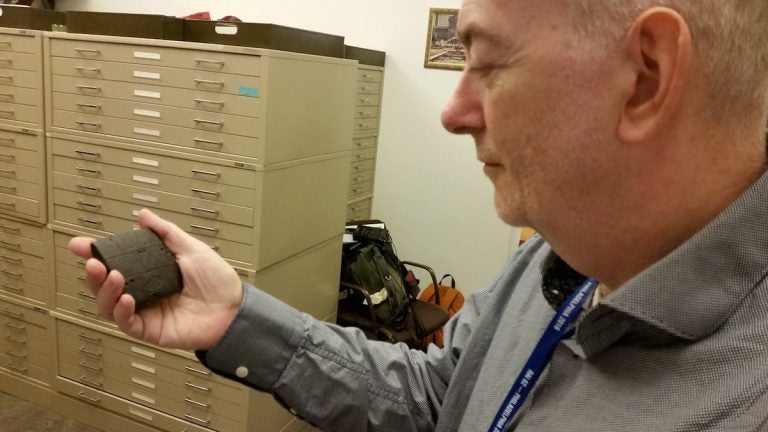Experts on ancient tablets gather in Philly with a mission
Listen
That's not a Blackberry. Philip Jones at the Penn Museum holds a 5000 year old cunieform tablet
Almost everyone in the world who knows how to read cuneiform tablets is in Philadelphia this week. About 300 people from 32 counties have come to the University of Pennsylvania for a major academic conference on ancient Mesopotamia, with the hope of helping restore knowledge lost to war and disruption.
The 62nd Rencontre Assyriologique Internationale, normally held in Europe, landed in Penn largely on the strength of its collection of ancient clay tablets. The university’s Museum of Archaeology and Anthropology has 30,000 of them, the largest American institutional collection in dug up by the institution, itself.
The theme of the conference is “Ur in the 21st Century.” The ancient Sumerian city of Ur was established about 5,000 years ago in what is now southern Iraq.
The title is a bit of a joke among Assyriologists. While scholars use 21st century techniques and technology to study the past, the glory days of Ur was its third dynasty, in 21st century B.C.
The city of Ur and the Mesopotamian region is not just the origin of mankind, generally, but the Penn Museum, specifically. In the 19th century the University of Pennsylvania founded its museum in order to house artifacts coming out of an archaeological dig in Nippur, an ancient Mesopotamian city near Ur.
In the 1920s, a team effort of Penn and the British Museum, led by Leonard Woolley, extensively excavated the Great Ziggurat of Ur. The temple gave up hundreds of thousands of artifacts, split between the Penn Museum, the British Museum, and Iraq.
Many of those artifacts are clay tablets, some of the oldest pieces of writing ever scribbled by humans.
“Once upon a time we had a nice little narrative that we…sorry, the Mesopotamians invented [writing] first, and the Egyptians copied the idea,” said Philip Jones, the keeper of the collection at the Penn Museum. “But one of the slight drawbacks of the last 30 years is that Egyptologists have been able to dig, whereas we haven’t. They found lots of early stuff, which is about the same period as our stuff.”
Jones let slip the Us vs. Them line between Assyriologists and Egyptologists. While both busy themselves with uncovering the origins of human society, recent turmoil in Iraq has put a damper on Assyriological discovery for three decades. Only in the last two years have archaeological digs been able to resume there.
“It’s mostly safe there, but due to problems several years ago in the looting of the Iraq museum there are problems in their records,” said conference coordinator Grant Frame.
For many scholars, the work is not finding new artifacts but pouring over what has already been disinterred. The conference this week includes papers on deciphering the science, religion, and art of the ancient Mesopotamians, much of it gleaned from close study of clay tablets.
Penn and the British Museum have begun an ambitious program to put all of their collective tablets online, so researchers don’t have to go to three countries to examine related artifacts. The Ur Online Project compiles images, descriptions, and original field notes from the Woolley expedition.
The site is still in its early stages, and does not yet have all of the tens of thousands of artifacts online. The online project puts the artifacts in context of other objects that were found around it.
When the Penn and British Museum artifacts go online, the two collections and the original field notes can triangulate what the Iraq museum lost.
“Our original concept back in ’03 when the Iraq museum got looted, if Philadelphia and London knew what they had from Ur, it should tell us what Iraq should have,” said Penn coordinator William B. Hafford. “Maybe that can help find out what went missing.”
WHYY is your source for fact-based, in-depth journalism and information. As a nonprofit organization, we rely on financial support from readers like you. Please give today.





